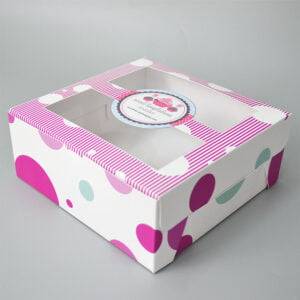Food safety is a paramount concern in the food industry, and it extends to every aspect of the culinary world, including cake preparation and delivery. Cake box packaging plays a significant role in ensuring that cakes remain safe to consume from the moment they leave the bakery until they reach the customer’s table. In this extensive guide, we will explore the critical role that cake box packaging plays in food safety. From materials and design considerations to best practices, we will cover everything you need to know to maintain the integrity of your cakes and the well-being of your customers.
The Importance of Food Safety in Cake Packaging
 Before delving into the specifics of cake box packaging, let’s understand why food safety is vital in the context of cake preparation and delivery:
Before delving into the specifics of cake box packaging, let’s understand why food safety is vital in the context of cake preparation and delivery:
1. Preventing Contamination
Cakes are susceptible to contamination from various sources, including bacteria, dust, and physical damage. Proper packaging helps prevent these contaminants from compromising the cake’s safety.
2. Preserving Freshness
Maintaining the freshness of cakes is essential for both taste and safety. Packaging can help extend the shelf life of cakes and prevent them from becoming stale or spoiling prematurely.
3. Protecting Against Allergens
In today’s environment of heightened food allergies and sensitivities, it’s crucial to prevent cross-contamination and clearly label allergenic ingredients on packaging to protect sensitive individuals.
4. Ensuring Hygiene During Transportation
During transit, cakes can be exposed to temperature fluctuations and potential mishandling. Packaging should provide insulation and protection to keep cakes safe during transport.
Cake Box Packaging and Food Safety
Now, let’s explore the specific ways in which cake box packaging contributes to food safety:
1. Material Selection
The choice of packaging material is critical. It should be food-safe and capable of protecting cakes from external contaminants. Common materials include cardboard, plastic, and paperboard, each with its own advantages and considerations.
2. Design for Protection
The design of cake boxes should prioritize the protection of cakes. Snug-fitting boxes with secure closures prevent cakes from shifting during transport, reducing the risk of damage.
3. Moisture Resistance
Cakes can be sensitive to moisture, which can lead to sogginess or mold growth. Packaging should have moisture-resistant properties to keep cakes dry and safe.
4. Allergen Labeling
For cakes containing allergenic ingredients, clear and prominent labeling is essential. It helps customers with allergies make informed choices and avoids accidental consumption.
5. Temperature Control
If your cakes require temperature control, consider packaging solutions that provide insulation and support for temperature-sensitive cakes. This is particularly important for cream-filled or refrigerated cakes.
6. Tamper-Evident Packaging
Seals and closures that are tamper-evident provide an additional layer of safety assurance. Customers can easily identify if the packaging has been tampered with before purchase.
7. Clear Handling Instructions
Include handling instructions on the packaging to guide customers on how to store and serve the cakes safely. This can prevent mishaps and maintain cake quality.
Best Practices for Cake Box Packaging and Food Safety
 To ensure the highest standards of food safety in cake box packaging, consider implementing these best practices:
To ensure the highest standards of food safety in cake box packaging, consider implementing these best practices:
1. Regular Training
Train staff members on proper cake handling, packaging, and labeling procedures to minimize the risk of contamination.
2. Quality Control
Implement strict quality control measures to inspect cakes before packaging and ensure they meet food safety standards.
3. Hygienic Environment
Maintain a clean and hygienic bakery environment to prevent contamination at the source.
4. Temperature Monitoring
If your cakes require specific temperature conditions, invest in temperature monitoring devices during transportation and provide clear temperature guidelines to customers.
5. Packaging Supplies
Regularly assess and maintain your packaging supplies to ensure they are clean, intact, and free from any contaminants.
Frequently Asked Questions (FAQ)
Q1: Can I use standard cardboard boxes for cake packaging?
A1: Standard cardboard boxes can be used for cake packaging if they are food-safe and meet the requirements for protecting cakes from contamination.
Q2: How can I prevent cakes from shifting during transport in cake boxes?
A2: Use cake boxes that are the right size and shape for your cakes, and consider using inserts like cake boards to provide stability.
Q3: What should I do if a customer has a food allergy and orders a cake?
A3: Clearly label allergenic ingredients on the packaging and inform your staff to take extra precautions to prevent cross-contamination when handling the cake.
Q4: Can I reuse cake boxes for environmental reasons?
A4: While reusing cake boxes can be environmentally friendly, ensure they are thoroughly cleaned and sanitized between uses to prevent contamination.
Q5: Should I invest in temperature-controlled packaging for all cakes?
A5: Temperature-controlled packaging is essential for cakes that require specific temperature conditions, such as refrigerated cakes or those with perishable fillings.
In Conclusion
Cake box packaging is not merely a vessel for cakes; it is a critical component of food safety in the bakery and confectionery industry. The right packaging materials, design, and practices can protect cakes from contamination, preserve their freshness, and provide essential information to customers. By following the guidelines and best practices outlined in this guide, you can ensure that your cake box packaging contributes to a safe and enjoyable cake experience for your customers while upholding the highest standards of food safety.
